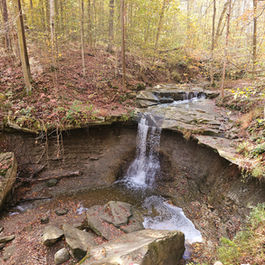Where the Trail Bends and the Bridge Beckons: Hiking Cuyahoga Valley's Furnace Run
- Dan Wagner

- Jul 7
- 3 min read
Updated: Jul 31
Hiking the Furnace Run Trail in Cuyahoga Valley National Park is a peaceful loop through dense forest, rolling hills, and streamside stretches. Depending on which direction you hike, the Everett Covered Bridge either welcomes you at the start or rewards you at the end. The bright red bridge—the last remaining covered bridge in Summit County—is a reconstructed 19th-century structure that adds a touch of historic charm to the trail. Along the way, you’ll encounter a mix of shaded hardwoods, gentle climbs, and the soothing sound of Furnace Run flowing nearby. Whether you begin or end your hike with the covered bridge, it’s a memorable highlight that ties together the natural beauty and cultural history of the park.


Trailhead elevation 748'
Water filterable along Furnace Run
Don't miss Everett Covered Bridge
Hiking the Furnace Run Trail
It’s a warm Fourth of July weekend morning when Heather and I arrive at the Everett Covered Bridge Trailhead. We’ve both hiked the Furnace Run Trail before, but never together. Since I enjoy stairs, we decide to hike the loop counterclockwise—tackling the staircase near the beginning rather than descending it at the end. From the parking area, we cross Everett Road to a clearly marked trail sign on the far side.

The path starts off flat but quickly reaches the winding staircase, where we begin to climb. In two-tenths of a mile, we ascend about 180 feet—what has to be the steepest stretch of trail in Cuyahoga Valley National Park.

At the top, the terrain levels out and winds through a shady mix of hardwoods and pine. A light blanket of pine needles cushions the trail, softening our footsteps as we walk.

A short while later, we cross Oak Hill Road and begin a gentle descent. Within a tenth of a mile, we reach a well-marked junction offering a shortcut or the full two-mile loop. We opt for the full route and continue steeply downhill.

At the bottom of the valley, the trail meanders through dense woods, crossing a wooden footbridge before entering a quiet stand of fragrant pines.

Soon after, we cross Everett Road and begin following the eastern bank of Furnace Run. We step off trail to the stream’s edge to admire the reflections on the water. Heather takes a few photos, including one of a snakeskin that she found, before we continue our hike.

The path continues alongside Furnace Run, weaving through a mix of tall pines, young saplings, and mature hardwoods.

Eventually, the trail leads us to the historic Everett Covered Bridge. We pause to take it in just as an older couple strolls through. “Look, isn’t that sweet,” Heather says with a smile.

From there, it’s a short walk along the crushed gravel path back to the trailhead.

We hop in the car and head to Szalay’s Farm & Market for some fresh fruit and something cold to drink—a local staple that rounds out any visit to the Everett Historic District.
Along the way, I point out to Heather the site of a Hopewell burial mound, discovered just a few hundred yards from the Everett Covered Bridge Trailhead back in 1875, when artifacts were unearthed during the construction of a schoolhouse. Measuring about 16 feet in diameter, the mound was later excavated in 1970 by a team from Case Western Reserve University. They uncovered a limestone crypt containing human remains along with copper and stone tools, beads, pottery sherds, gorgets, and charred animal bones—evidence of a mortuary ceremony and a sign that the Hopewell once inhabited the valley.

Today, the mound lies quietly along the side of Everett Road, entirely hidden among the trees and other vegetation, unnoticed by the many park visitors who pass by without realizing its historical significance. A second, more easily recognizable Hopewell mound—often called the Botzum Mound—can be found within the park near the Botzum Trailhead.
_edited.png)









































Comments